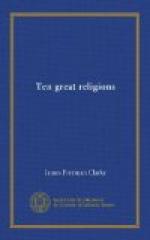That mankind is so divided into races of men it would seem hardly possible to deny. It is proved by physiology, by psychology, by glossology, and by civil history. Physiology shows us anatomical differences between races. There are as marked and real differences between the skull of a Hindoo and that of a Chinaman as between the skulls of an Englishman and a negro. There is not as great a difference, perhaps, but it is as real and as constant. Then the characters of races remain distinct, the same traits reappearing after many centuries exactly as at first. We find the same difference of character between the Jews and Arabs, who are merely different families of the same Semitic race, as existed between their ancestors, Jacob and Esau, as described in the Book of Genesis. Jacob and the Jews are prudent, loving trade, money-making, tenacious of their ideas, living in cities; Esau and the Arabs, careless, wild, hating cities, loving the desert.
A similar example of the maintaining of a moral type is found in the characteristic differences between the German and Kelts, two families of the same Indo-European race. Take an Irishman and a German, working side by side on the Mississippi, and they present the same characteristic differences as the Germans and Kelts described by Tacitus and Caesar. The German loves liberty, the Kelt equality; the one hates the tyrant, the other the aristocrat; the one is a serious thinker, the other a quick and vivid thinker; the one is a Protestant in religion, the other a Catholic. Ammianus Marcellinus, living in Gaul in the fourth century, describes the Kelts thus (see whether it does not apply to the race now).
“The Gauls,” says he, “are mostly tall of stature,[8] fair and red-haired, and horrible from the fierceness of their eyes, fond of strife, and haughtily insolent. A whole band of strangers would not endure one of them, aided in his brawl by his powerful and blue-eyed wife, especially when with swollen neck and gnashing teeth, poising her huge white arms, she begins, joining kicks to blows, to put forth her fists like stones from a catapult. Most of their voices are terrific and threatening, as well when they are quiet as when they are angry. All ages are thought fit for war. They are a nation very fond of wine, and invent many drinks resembling it, and some of the poorer sort wander about with their senses quite blunted by continual intoxication.”
Now we find that each race, beside its special moral qualities, seems also to have special religious qualities, which cause it to tend toward some one kind of religion more than to another kind. These religions are the flower of the race; they come forth from it as its best aroma. Thus we see that Brahmanism is confined to that section or race of the great Aryan family which has occupied India for more than thirty centuries. It belongs to the Hindoos, to the people taking its name from the Indus, by the tributaries




